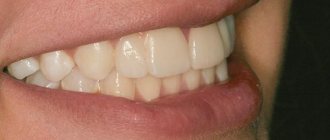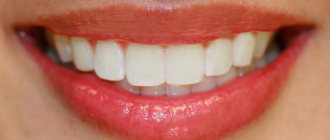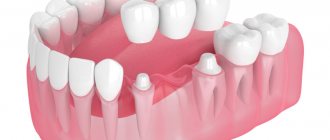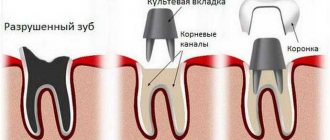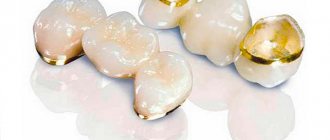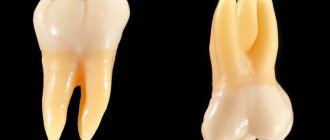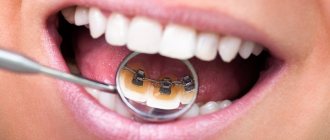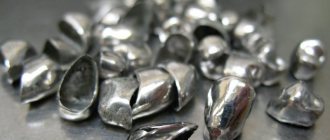The concept of “eye” teeth does not relate to medical terminology - it is, rather, a popular term that refers to the upper, and with them, the lower canines. There is an assumption that this name arose due to the proximity of the facial nerve, the impact of which is accompanied by severe painful sensations radiating in the fundus of the eye. Fang extraction is a complex procedure that requires the use of strong painkillers.
Which teeth exactly have such a strange name?
So, the term “eye teeth” is not a medical term. The correct name for these teeth is upper canines. Where did such a strange name come from? The fact is that in the immediate vicinity of the upper fangs there are threads of the facial nerve. When these threads are irritated, very severe pain occurs in the upper part of the face. This pain even extends to the eyes.
When babies' upper canines begin to erupt, pain occurs that makes children cry. Unfortunately, this process takes quite a long time. Removal of eye teeth in adults is also always accompanied by severe pain. In this case, dentists use very strong anesthesia.
From somewhere there are ridiculous rumors that a person can even go blind from the removal of eye teeth. Such cases are unknown to medicine.
Removing eye units is challenging
Not only teething, but also the removal of fangs, and even their absence, cause certain difficulties. For example, the procedure for removing fangs itself is considered quite difficult; after it, severe swelling, pain, the development of an inflammatory process, and even deterioration of vision are possible if the optic nerve is damaged (due to traumatic removal or complications during the recovery period after the procedure). And the absence of “eye teeth” and their untimely restoration can make it difficult to pronounce certain sounds, which will impair diction and speech.
Removing fangs is a rather complicated procedure.
Also, do not forget that the fangs are located in the frontal zone of the smile, so their absence will directly affect the aesthetics of the entire face. In addition, it is the canines that serve as excellent support for the orbicularis oris muscle; if they are missing, the muscle around the mouth will become flabby and increase age.
Notice
: Undefined variable: post_id in
/home/c/ch75405/public_html/wp-content/themes/UltraSmile/single-item.php
on line
45 Notice
: Undefined variable: full in
/home/c/ch75405/public_html/wp-content /themes/UltraSmile/single-item.php
on line
46
Rate this article:
( 3 ratings, average: 5.00 out of 5)
prevention
Consulting specialist
Chorny Stanislav Vladimirovich
Doctor rating: 9.8 out of 10 (4) Specialization: Orthopedist Experience: 19 years
External features of eye teeth
Eye teeth are visually very different from both the front teeth and molars. The eye tooth has only one root. It is relatively long and slightly flattened. The crowns of the eye teeth have two cutting edges located at an acute angle to each other. They also have a slightly flattened shape.
The upper eye teeth are noticeably larger and longer than the lower ones. Their cutting surface is much wider than that of the lower canines.
Nature entrusted these teeth to hold food in the mouth and tear food into pieces.
Possible complications and diagnosis
If the disease is not treated properly, very serious complications soon develop: osteomyelitis (purulent inflammation of bone tissue, provoking its necrosis), phlegmon (a diffuse purulent process that affects nearby tissues and requires immediate surgical intervention), sepsis (a general infection of the body, often ending in the death of the patient ). Each of these conditions requires emergency medical care and long, painstaking treatment. Therefore, it is better not to let the situation lead to complications and contact a dentist at the first signs of an inflammatory process.
To establish an accurate diagnosis, the doctor will need to conduct a differential diagnosis using instrumental diagnostic methods (radiography, CT). This disease is similar in symptoms to acute periodontitis, acute inflammation of the salivary glands, lymphadenitis, and osteomyelitis. Therefore, in order to prescribe adequate treatment, it will be necessary to exclude these conditions and accurately determine the cause of the patient’s poor health.
Formation of eye teeth in children
Children's milk teeth erupt in a strictly defined sequence. Each tooth is waiting its turn to appear in the baby’s mouth.
Children's eye teeth begin to erupt only after all the incisors and first molars have appeared. The upper canines begin to erupt first. This usually happens at the age of one and a half years. The lower canines begin to appear when the baby is 20 months old.
This delay is explained by the fact that the roots of the eye teeth penetrate into the depths of the bone tissue much deeper than the other teeth.
During eye teething, children experience more than just pain. Most of them experience a slight increase in body temperature. Running noses and even swelling in the oral cavity often occur. Young mothers often perceive all this as a child’s illness. Meanwhile, this is a completely natural, albeit unpleasant, process. It cannot be any other way, because at this time the gums next to the baby’s teething teeth become inflamed.
Only in the rarest cases can babies experience coughing, diarrhea and even vomiting at this time. However, these are symptoms of another random disease that has nothing to do with the appearance of eye teeth.
Comments
My fangs stick out terribly, they seem to be incredibly long, like a vampire's, sticking out and pushed forward. I don’t like it, I’m embarrassed to smile because of them. Tell me, is it possible to somehow correct the situation, maybe file them down?
Marina (01/20/2019 at 08:56 pm) Reply to comment
- Dear Marina. The most correct decision for you will be an orthodontist, who, based on your situation, will select the appropriate corrective device option. If the fangs are healthy, then there is no need to file them down or put a crown on them, for example. Also, most likely it will not be possible to install a veneer, because... in case of significant deviations from the norm, this lining will not be able to solve the problem, and the tooth enamel will have to be greatly ground down, which is completely useless if it is healthy and intact. Consult with several doctors so that you can choose the best solution for your problem.
Editorial staff of the portal UltraSmile.ru (01/23/2019 at 08:24) Reply to comment
The article is useful for understanding those who do not know anything about eye teeth. And this is a simple explanation, fangs around the edges. Do I understand correctly that the eye teeth need to be removed if there is curvature of the fangs?
Peter (01/30/2019 at 08:29) Reply to comment
The child's eye teeth have erupted. How painful it is, I remember how it was when I was a child. Can fangs hurt from time to time and what do you recommend to do so that my daughter stops experiencing pain?
Raisa (01/30/2019 at 08:47) Reply to comment
I'm anxiously awaiting the baby's eye teeth. Two molars came out at the same time. Three days of fever and diarrhea. Viburkol suppositories do not help much. Maybe there are other candles so that they are also not very harmful?
Ekaterina (01/31/2019 at 14:04) Reply to comment
- Ekaterina, you should definitely contact your pediatrician. You can’t just choose candles based on useful tips posted on the Internet. For our part, we try to do only reviews of drugs, but we still insist that readers use them as prescribed by doctors. Especially when it comes to young children.
Editorial staff of the portal UltraSmile.ru (01/31/2019 at 14:21) Reply to comment
Recently, the child’s eye teeth began to appear. The child became restless. He doesn't sleep well at night. The temperature began to rise and diarrhea began. Well, for us it doesn’t last long, only three days.
Anastasia (02/12/2019 at 11:52 am) Reply to comment
Write your comment Cancel reply
How to ease the baby's suffering?
It is impossible to ensure completely painless eruption of eye teeth. However, you can help your baby in several ways.
A light massage of the gums slightly dulls the pain. In any case, this stops the kids from crying. To do this, you need to gently stroke the gum just above the eye tooth for a couple of minutes. This massage can be done two to three times a day.
Now pharmacies sell special teethers. Before using, keep them in the refrigerator for a while. These simple products are filled with distilled water. If the baby bites through the shell, then nothing bad will happen.
You can dull the pain with the help of anesthetic gels Dentinox, Kalgel or Kamistad. They begin to act a few minutes after application to the gums.
If the baby’s nose is stuffy during the teething of the eye teeth, then in this case it is worth using drops of Otrivin, Nazivin or Quix. They tend to constrict blood vessels. It also happens that the body temperature of babies rises to 38 degrees or higher. In this case, you have to resort to antipyretic children's drugs paracetamol or ibuprofen. They are available in the form of syrups or candles.
If the baby is having too much trouble with the teething of the eye teeth, then in such a situation it is better to call a pediatrician at home.
Eruption of canines in infancy
The order of formation of the primary occlusion provides for the appearance of fangs after the incisors and the first chewing units have erupted. The upper elements emerge at the age of 1.2-1.5 years, which is slightly earlier than the period of formation of the lower molars. Late eruption is determined by the deep position of the units in the structure of the jaw, which also determines the characteristic painful sensations that may occur during growth.
To relieve the discomfort experienced by the child, the following techniques are recommended:
- Massage of gum tissue - before the procedure, you need to thoroughly wash your hands, then use your index finger to massage the area above the canine for a couple of minutes. It is recommended to repeat the massage several times a day;
- The use of teethers that provide a cooling effect - a product filled with distilled water does not pose a danger to the baby’s health even if the baby manages to chew the shell;
- Applying anesthetic gels that relieve inflammation within a few minutes;
- For nasal congestion, use children's nasal medications that promote vasoconstriction;
- At elevated temperatures (more than 38 degrees) - take fever medications, available in the form of syrup or suppository.
It is worth emphasizing that the use of medications must be agreed with a doctor, who will determine the appropriate list, as well as the duration of the course.
Eye teeth in teenagers
The permanent lower eye teeth are formed at the age of 9-10 years. The upper fangs appear after 1-2 years.
In a healthy child, the formation of permanent eye teeth is painless. If this process is accompanied by pain, then this indicates a serious problem. This usually happens if diseases of the oral cavity occur, such as gumboil, pulpitis, periodontitis or other inflammatory processes. In such a situation, you should not try to get rid of the problem yourself. The most you can do is take a painkiller and immediately go to the dentist.
Permanent fangs
At the age of 7 to 9 years, baby fangs begin to change into “adult”, permanent ones, which a person will have for the rest of his life, under conditions of appropriate care and the genetic predisposition of the teeth to longevity. Fangs very rarely suffer from caries or any other pathologies.
Undesirability of deletion
The inconsistency of rumors about possible blindness after removal of fangs, especially the upper ones, is written above. An exception is the pathology of the development of the canine and its root, when the optic nerve can come into contact with the nerves of the canine root. Then careless extraction, disrupting the canal of the optic nerve, can cause one-sided blindness on the half of the face where the extraction took place. To avoid this, be sure to take an x-ray of the roots and jaw. The resolution of X-ray machines in dental clinics makes it possible to examine and recognize pathology so that subsequent surgery can proceed without complications. And a consultation with an orthodontist and an orthopedic dentist is required to look for opportunities to save the tooth.
Fangs play a big role in pronouncing individual sounds, so removing either the upper or lower eye teeth can lead to a decrease in the quality of diction.
When the dentition is deprived of fangs, whose main function is tearing and tearing solid food, their “duties” begin to be performed by the incisors and, to a lesser extent, premolars (teeth No. 4 and 5). This means that the load on these teeth increases.
Symptoms
Eye teeth often cause the most intense symptoms in a child. If in infants such manifestations are associated exclusively with well-being, then when the fangs erupt, a deterioration in behavior, capriciousness and disobedience is already noted.
The main symptoms may be:
- redness and swelling of the gum tissue at the site of eruption;
- an increase in temperature of one or two degrees;
- indigestion, diarrhea;
- increased activity of the salivary glands.
During this period, the child falls asleep and sleeps worse, shows a desire to chew fingers or other objects, his appetite may worsen and weight gain may stop. If the process is difficult, then the following symptoms may also appear:
- from the eyes – conjunctivitis, lacrimation;
- from the respiratory system - swelling of the mucous membranes of the nose, which leads to impaired nasal breathing or a slight runny nose.
There is no need to worry ahead of time, since many children grow fangs almost asymptomatically, and the appearance of a new tooth in the child’s mouth becomes an unexpected surprise for parents.
A situation in which the temperature rises above 38°C, severe diarrhea, vomiting, or the child constantly cries is not considered normal. During the period of teething, the baby’s immunity decreases, so the body is more quickly affected by diseases, and such sharp symptoms indicate that a pathological process has begun. In this case, you must urgently contact your pediatrician or family doctor.
Where are they located
They are located on the upper and lower jaws. These are paired canines that are adjacent to the lateral molars on one side, and to the small ones on the other. In the embryo, eye teeth begin to form in the second month of intrauterine development. Like the others, they are formed from the dental epithelial plate, however, they penetrate deeper into the bone tissue than others.
The canine structure is no different from other teeth. If we consider the anatomical structure, the teeth are divided into 3 parts. The part that is above the gum is called the crown. The neck begins from it, it is covered by the gums and ends with the root, which, in fact, holds the tooth in the jaw.
The root can be single or have shoots. Since we are talking about a fang, it must be said that it has one root without branches. It itself consists of several tissues, but mainly dentin. In the root part, the dentin is covered by cement, and the crown is covered by enamel. Enamel is the hardest substance in the human body and is necessary for the tooth to protect itself.
The nutrition of these teeth, like all others, is provided by the pulp - it is located inside the tooth and consists of blood and lymphatic vessels, as well as nerve cells. A nerve runs through the center and is located in the dental canal.
The anatomy is clearly shown in the video below:
